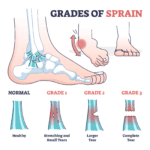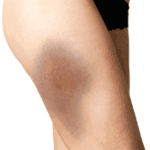Introduction
Shin splints, also known as medial tibial stress syndrome, is a common condition that causes pain along the inner edge of the shinbone (tibia). It often affects athletes, dancers, and military personnel, particularly those engaging in repetitive, high-impact activities. This article explores the causes, symptoms, risk factors, and effective treatments for shin splints, as well as prevention strategies to avoid recurrence.
Causes of Shin Splints
Shin splints occur when repetitive stress causes inflammation in the muscles, tendons, and bone tissue around the tibia. Common causes include:
- Overuse Injuries:
- Repeated stress from physical activity can overload the lower leg muscles and tendons.
- Improper Foot Mechanics:
- Flat feet or rigid arches can increase stress on the tibia.
- Inadequate Footwear:
- Worn-out or unsupportive shoes fail to absorb impact properly.
- Sudden Activity Changes:
- Quickly increasing workout intensity, duration, or frequency.
Symptoms of Shin Splints
Recognizing the symptoms early is crucial for effective treatment. Key symptoms include:
- Pain:
- Dull or sharp pain along the inner part of the shin.
- Swelling:
- Mild swelling in the lower leg.
- Tenderness:
- Soreness or sensitivity along the inner edge of the shinbone.
Risk Factors for Shin Splints
Certain factors make individuals more prone to shin splints:
- Rapid Activity Increases:
- Sudden escalation in workout routines or physical demands.
- High-Impact Sports:
- Activities like running, basketball, or military training.
- Hard Surfaces:
- Exercising on concrete or other unforgiving surfaces.
- Inadequate Recovery Time:
- Not allowing sufficient rest between workouts.
Diagnosis of Shin Splints
Diagnosing shin splints involves:
- Medical History:
- A thorough review of symptoms and activity patterns.
- Physical Examination:
- Assessment of the affected area for tenderness and swelling.
- Imaging Tests:
- X-rays or MRI to rule out stress fractures or other conditions.
Treatment for Shin Splints
Managing shin splints involves rest and supportive care:
- Rest:
- Avoid activities that cause pain for 2-4 weeks.
- Ice Therapy:
- Apply ice packs for 15-20 minutes, several times daily, to reduce inflammation.
- Compression and Elevation:
- Use compression bandages and elevate legs to alleviate swelling.
- Stretching and Strengthening:
- Perform exercises to improve flexibility and strengthen leg muscles.
- Proper Footwear:
- Invest in well-cushioned, supportive shoes to minimize stress on the legs.
Prevention Strategies for Shin Splints
Preventing shin splints requires proactive steps:
- Gradual Progression:
- Increase workout intensity and duration slowly.
- Cross-Training:
- Incorporate low-impact exercises like swimming or cycling.
- Proper Warm-Up and Cool-Down:
- Always prepare muscles before exercise and cool down afterward.
- Supportive Shoes and Insoles:
- Use footwear designed for your activity and foot mechanics.
When to Seek Medical Attention
Consult a doctor if you experience:
- Persistent pain despite rest and home care.
- Severe swelling or difficulty walking.
- Recurring shin pain with physical activity.
Conclusion
Shin splints are a preventable and treatable condition. By understanding the causes and risk factors, adopting proper training practices, and seeking early intervention, you can avoid long-term complications like stress fractures. Incorporating the outlined prevention strategies will help ensure healthy, pain-free physical activity.





